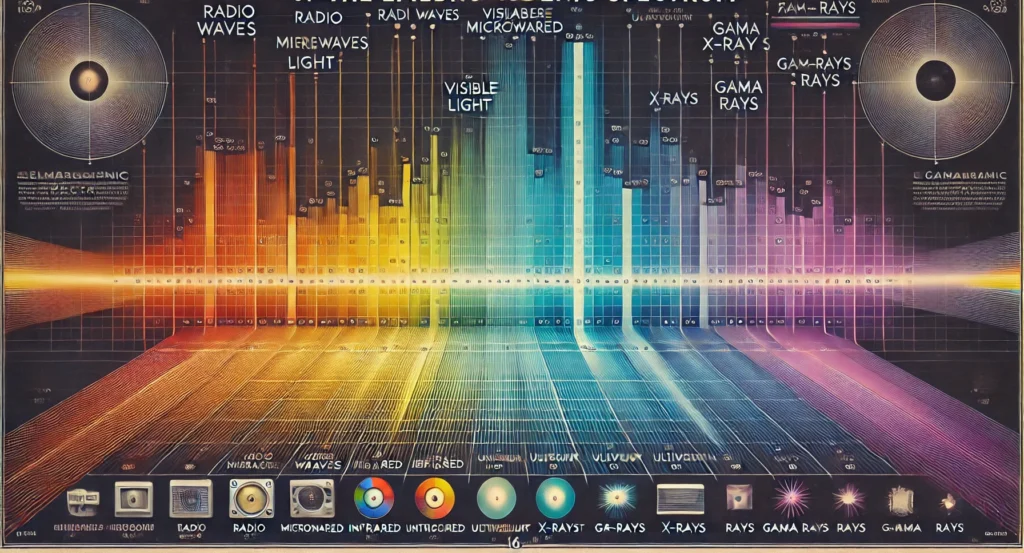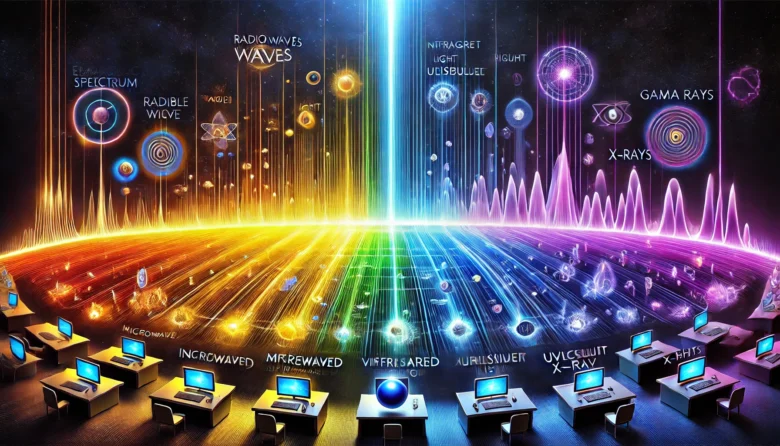Picture waking up one day to a world completely stripped of light, sound, or Wi-Fi signals. It would feel like being cast into an abyss, cut off from the very essence of our daily life. Yet, all these aspects—light, sound, and Wi-Fi—are manifestations of one of the most fundamental phenomena in physics: electromagnetic radiation. The physics of electromagnetic radiation is not just a concept buried in physics textbooks; it’s an integral part of the technology we use, the natural world we observe, and even the medical treatments we rely on. So, let’s dive into this fascinating topic and explore how electromagnetic radiation shapes our world.
What Is Electromagnetic Radiation?
Essentially, electromagnetic radiation is energy that moves through space at the speed of light. It includes many types; from the visible light we see with our eyes to the invisible ultraviolet rays that give us sunburns and even microwaves that heat our food. But what ties them all together? It’s their wave-like behaviour.
Electromagnetic radiation can be understood as a wave, where electric and magnetic fields vibrate at right angles to each other and the wave’s direction of travel. These waves vary in length—from the very short gamma rays, smaller than an atom, to the much longer radio waves, which can be kilometres long.
Simply put, electromagnetic radiation is energy on the move, whether beaming down from the sun or bouncing around in your microwave.

The Electromagnetic Spectrum: The Universe’s Palette
Electromagnetic radiation covers a broad spectrum of wavelengths, collectively known as the electromagnetic spectrum. This spectrum is like a vast palette of colours, each representing different forms of energy:
Radio Waves: The gentle giants of the spectrum, radio waves have the longest wavelengths. They are used in everything from radio broadcasting to TV signals and even GPS. How does your car’s radio tune into your favourite station? That’s the work of radio waves, transmitting sound across vast distances.
Microwaves: Microwaves are a bit shorter in wavelength and are famous for heating food. But beyond the kitchen, they’re also used in radar technology and for transmitting information over long distances, like in satellite communications.
Infrared Radiation: Beyond the visible spectrum, infrared radiation is felt as heat. We sense it when considering the sun’s warmth or a campfire. Infrared cameras, often used in night-vision equipment, detect this type of radiation.
Visible Light: This is the narrow band of the spectrum that human eyes can detect. From violet to red, visible light makes the world vibrant and colourful.
Ultraviolet (UV) Radiation: Just beyond visible light lies UV radiation. While UV rays from the sun give you a tan (or a burn), they also play a crucial role in producing vitamin D in our bodies.
X-rays: With even shorter wavelengths, X-rays can penetrate most materials, which is why they are invaluable in medical imaging. They help doctors see inside the human body without surgery.
Gamma Rays: Gamma rays, found at the far end of the spectrum, originate from the universe’s most powerful events, such as supernovae and radioactive decay. These rays have the power to kill cancer cells but must be handled with extreme care due to their destructive potential.
Real-World Applications: How Electromagnetic Radiation Impacts Us
Electromagnetic radiation is not just a theoretical concept; it has numerous practical uses that impact our everyday lives in ways we often overlook.
Communication: Our entire modern communication system, from the Internet to mobile phones, relies on the transmission of electromagnetic waves. The next time you make a video call or send a text, remember that you’re essentially using controlled electromagnetic radiation to communicate with someone miles away.
Medicine: Electromagnetic radiation is a powerful tool in medicine. X-rays allow doctors to peer inside the human body. Radiation therapy uses focused beams of gamma rays to treat cancer. MRI machines use a combination of radio waves and magnetic fields to produce detailed images of the body.
Astronomy: Astronomers use electromagnetic radiation to study the universe. Different wavelengths provide unique insights into celestial objects, from the microwave background radiation that gives clues about the early universe to gamma rays that indicate high-energy events like supernovae.
The Physics Behind Electromagnetic Waves
Let’s explore the science further—don’t worry, we’ll keep it simple! Electromagnetic waves are generated whenever charged particles, like electrons, accelerate. Imagine shaking a rope tied at one end; the wave that travels down the rope is similar to how electromagnetic waves propagate through space.
Every wave has a distinct wavelength (the distance between two successive peaks) and frequency (the number of waves passing a point per second). These two properties are inversely related—shorter wavelengths have higher frequencies, and vice versa.
The energy carried by electromagnetic waves is directly proportional to their frequency. That’s why gamma rays, with their extremely high frequency, are so powerful, while radio waves, with their low frequency, carry much less energy.
How Electromagnetic Radiation Interacts with Matter
When electromagnetic radiation encounters matter, it can be absorbed, reflected, or transmitted, depending on the material’s properties and the radiation’s wavelength.
Absorption: When a material absorbs electromagnetic radiation, it takes in the energy and may convert it into heat. This is why the pavement gets hot on a sunny day; it absorbs visible light and converts it to heat.
Reflection: Some materials, like mirrors, reflect electromagnetic waves. This is why you can see your reflection in a mirror; it reflects visible light back to your eyes.
Transmission: Transparent materials, like glass, allow electromagnetic waves to pass through them. This is why you can see through a window—visible light is transmitted through the glass.
Everyday Examples and Case Studies
Microwave Ovens: Microwave ovens heat food by emitting microwaves that water molecules in the food absorb, causing them to vibrate and generate heat, which cooks the food. That’s why foods with more water, like soup, heat up faster in the microwave.
Sunscreen: Sunscreen shields your skin from damaging UV rays by either absorbing or reflecting them. The SPF (Sun Protection Factor) rating tells you how much sunscreen can block UV radiation. Applying sunscreen reduces your risk of sunburn and skin cancer by preventing UV radiation from penetrating your skin.
Wi-Fi: Wi-Fi networks utilize radio waves to transmit data wirelessly between your devices and the router. These waves are short enough to travel through walls and ceilings, allowing you to access the Internet anywhere in your home.
Conclusion
Electromagnetic radiation is a core element of the physical world, influencing everything from the warmth we feel from the sun to the technology we use to communicate. By understanding the physics of electromagnetic radiation, we gain insight into the invisible forces that shape our daily lives. So, the next time you turn on a light, cook with a microwave, or step outside on a sunny day, take a moment to appreciate the remarkable science of electromagnetic radiation at work.
Author’s Note
As a lifelong science enthusiast, I find studying electromagnetic radiation endlessly fascinating. It’s a topic that connects the everyday with the extraordinary, from the warmth of sunlight to the far reaches of the cosmos. This blog has sparked your curiosity and deepened your appreciation for the invisible wonders around us.
G.C., Ecosociosphere contributor.





Comments
É como se você lesse minha mente Você parece saber muito sobre isso, como se você tivesse escrito o livro nele ou algo assim. Acho que você poderia fazer com algumas fotos para transmitir um pouco a mensagem, mas em vez disso, este é um blog fantástico. leia eu certamente voltarei